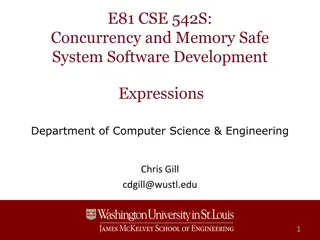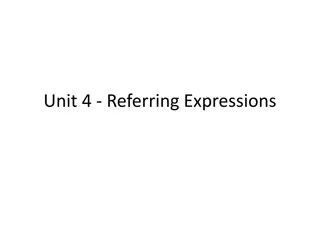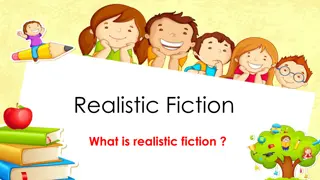Language and Fiction: Predicates, Referring Expressions, Unreal Worlds
Explore the concepts of predicates, referring expressions, and unreal worlds in language. Understand generic sentences, imaginary creatures, and the use of language to talk about non-existent things. Delve into the broad interpretation of referring expressions and the possibility of using them in utterances to refer to real or fictitious entities.
Uploaded on Sep 30, 2024 | 0 Views
Download Presentation

Please find below an Image/Link to download the presentation.
The content on the website is provided AS IS for your information and personal use only. It may not be sold, licensed, or shared on other websites without obtaining consent from the author.If you encounter any issues during the download, it is possible that the publisher has removed the file from their server.
You are allowed to download the files provided on this website for personal or commercial use, subject to the condition that they are used lawfully. All files are the property of their respective owners.
The content on the website is provided AS IS for your information and personal use only. It may not be sold, licensed, or shared on other websites without obtaining consent from the author.
E N D
Presentation Transcript
Unit 6-Part 2 Predicates, Referring Expressions, and Universe of Discourse
Generic Sentence A GENERIC SENTENCE is a sentence in which some statement is made about a whole unrestricted class of individuals, as opposed particular individual. The whale is a mammal (understood in the most usual way) is a generic sentence. That whale over there is a mammal is not a generic sentence. Note that generic sentences can be introduced by either a or the (or neither).
Are the following Generic Sentences? (1)Gentlemen prefer blondes Yes / No (2) Jasper is a twit (3) Till male of the species guards the eggs Yes / No Yes / No (4) A wasp makes its nest in a hole in a tree Yes / No (5) A wasp just stung me on the neck Yes / No
Unreal Worlds and Non-existent Things Language is used for talking about things in the real world, like parrots, paper-clips, babies, etc. All of these things exist. But the things we can talk about and the things that exist are not exactly the same. We shall now explore the way in which language creates unreal worlds and allows us to talk about non-existent things. We start from the familiar notion of reference. Our basic, and very safe definition of reference (Unit 3) was as a relationship between part of an utterance and a thing in the world. But often we use words In a way which suggests that a relationship exactly like reference holds between a part of an utterance and non-existent things. The classic case is that of the word unicorn.
Imaginary Creatures and Fairy Tale Worlds (1) Do unicorns exist in the real world? (2) In which two of the following contexts are unicorns most frequently mentioned? Circle your answer. (a) in fairy stories (b) in news broadcasts (c) in philosophical discussions about reference (d) in scientific text books (3) Is it possible to imagine worlds different in certain ways from the world we know actually to exist? (4) In fairy tale and science fiction worlds is everything different from the world we know? (5) In the majority of fairy tales and science fiction stories that you know, do the fictional characters discourse with each other according to the same principles that apply in real life? (6) Do fairy tale princes, witches, etc. seem to refer in their utterances to things in the world? Yes / No Yes / No Yes / No Yes / No Yes / No
We adopt a broad interpretation of the notion referring expression so that any expression that can be used to refer to any entity in the real world or in any imaginary world will be called a referring expression. Note: We will avoid disputes between atheist and theist semanticists. According to this view of what counts as a referring expression, are the following possible referring expressions, i.e. could they be used in utterances to refer (either to real or to fictitious entities)? (1) God Yes/No (3) Moses Yes/No (2) and Yes/No (4) that unicorn Yes/No
The case of unicorns was relatively trivial. Now we come to some rather different cases. (1) If unicorns existed, would they be physical objects? Yes/No (2) Do the following expressions refer to physical objects? (a) Christmas Day 1980 (b) one 0 'clock in the morning (c) when Eve was born (d) 93 million miles (e) the distance between the Earth and the Sun Yes/No (f) God Save the Queen" (g) the British national anthem (h) eleven hundred (i) one thousand one hundred Yes/No Yes/No Yes/No Yes/No Yes/No Yes/No Yes/ No
Particular Times, Songs, Numbers, Years etc. Can these be referring expressions? So far we have mainly kept to examples of reference to physical objects, like John, my chair, the cat and Cairo. What are we to make of expressions like tomorrow and the British national anthem, which can- not possibly be said to refer to physical objects? It is in fact reasonable to envisage our notion of reference in such a way that we can call these referring expressions also, because language uses these expressions in many of the same ways as it uses the clear cases of referring expressions. Even though expressions like tomorrow, the British national anthem, eleven hundred, the distance between the Earth and the Sun etc. do not indicate physical objects, language treats these expressions in a way exactly parallel to referring expressions. We call them referring expressions along with John, the roof, and Cairo. We say that the British national anthem is used to refer to a particular song, that eleven hundred is used to refer to a particular number, one 0 'clock to a particular time , 93 million miles to a particular distance, and so on. Language is used to talk about the real world, and can be used to talk about an infinite variety of abstractions, and even of entities in imaginary, unreal worlds.
The UNIVERSE OF DISCOURSE for any utterance as the particular world, real or imaginary (or part real part imaginary) that the speaker assumes he is talking about at the time. When an astronomy lecturer, in a serious lecture, states that the Earth revolves around the Sun, the universe of discourse is, we all assume, the real world (or universe). When I tell my children a bedtime story and say "The dragon set fire to the woods with his hot breath", the universe of discourse is not the real world but a fictitious world.
Is the universe of discourse in each of the following cases the real world (as far as we can tell) (R), or a (partly) fictitious world (F)? (1) Newsreader on April 14 th ] 981: "The American space shuttle successfully landed at Edwards Airforce Base, California, today" R I F (2) Mother to child: "Don't touch those berries. They might be poisonous" (3) Mother to child: "Santa Claus might bring you a toy telephone" (4) Patient in psychiatric ward: "As your Emperor I command you to defeat the Parthians" (5) Doctor to patient: "You cannot expect to live longer than another two months" (6) Patient (joking bravely): "When I'm dead, I'll walk to the cemetery to save the cost of a hearse" R / F R / F R / F R / F R / F
These were relatively clear cases. Note that no universe of discourse is a totally fictitious world. Santa Claus is a fiction, but the toy telephones he might bring do actually exist. So in examples like this we have inter- action between fact and fiction, between real and imaginary worlds. When two people are arguing at cross-purposes they could be said to be working within partially different universes of discourse. Theist: "Diseases must serve some good purpose, or God would not allow them" Atheist: "I cannot accept you premises" Here the theist is operating with a universe of discourse which is a world in which God exists. The atheist's assumed universe of discourse is a world in which God does not exist.
In the following situations, are the participants working with the same universe of discourse (S), or different universes (D), as far as you can tell? (1) A: "Did Jack's son come in this morning?" B: "I didn't know Jack had a son" A: "Then who's that tall chap that was here yesterday?" B: "I don't know, but I'm pretty sure Jack hasn't got any kids" . A: "I'm sure Jack's son was here yesterday" (2) Time traveler from the eighteenth century: "Is the King of France on good terms with the Tsar of Russia?'" Late twentieth-century person: "Huh?" (3) Optician: "Please read the letters on the bottom line of the card Patient: "E-G D Z Q N B A" Optician: "Correct. Well done" S / D S / D S / D
Assuming the same universe of discourse is essential to successful communication. The participants in questions (l) and (2) are in a sense talking about different worlds, (Assuming different universes of discourse is not the only reason for breakdown of communication: There can be other causes: -both participants' assuming that exactly the same entities exist in the world, but referring to them by different words -(an extreme case of this would be two participants speaking different languages) - or, of course, sheer inarticulacy.)
Summary In the course of utterances, speakers use referring expressions to refer to entities which may be concrete or abstract, real or fictitious. The predicates embedded in a referring expression help the hearer to identify its referent. Semantics is not concerned with the factual status or things in the world but with meaning in language. The notion of universe of discourse is introduced to account for the way in which language allows us to refer to non-existent things.
Assignment for Next Class Unit 9 : Sense Properties Practices: 1-7 Bonus assignment due: Section D: 25-11-12 Section C: 26-11-12 OR Earlier























